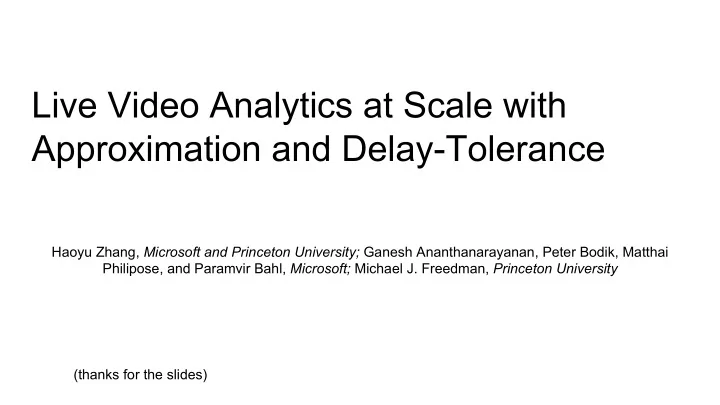

Live Video Analytics at Scale with Approximation and Delay-Tolerance Haoyu Zhang, Microsoft and Princeton University; Ganesh Ananthanarayanan, Peter Bodik, Matthai Philipose, and Paramvir Bahl, Microsoft; Michael J. Freedman, Princeton University (thanks for the slides)
Computer vision background Fast GPU:s has made matrix multiplication extremely cheap, which has enabled deep learning whose central learning scheme is based on matrix multiplication Computer vision, powered by deep learning, is now better than humans at a variety of vision tasks Classification takes vast resources...
Real world analytics The article considers real time video analytics, motivated by smart cities We have queries such as car counting, license plate identification for tolling and identification of cars containing kidnapped kids with different lag-resistances and quality needs In a real world setting we are often overwhelmed by data, and cannot use the biggest neural network on all data We need to judiciously schedule resources for correctly chosen machine learning tasks
Video-storm, contributions The authors implement video-storm, a system that perform queries on video data The first major contribution is a method of profiling the resource usage versus quality trade-off in machine learning models and their pipelines The second contribution is a system that schedules and configures machine learning algorithm for real-time queries on videos
Video-storm at a glance At offline time, we profile different settings to understand resource/quality tradeoffs Online we periodically consider all queries and assign resources, configurations and so on Each query has a utility function that describes its quality and lag requirements, we maximize total utility or minimum utility
Related work: scheduling There has previously been a lot of work done in scheduling In the video analytics setting the requirements of a job is not fixed, and we can move along the resource-quality curve at times with high traffic, this makes scheduling tricky The authors additionally considers a setting where all queries comes from the same agent, which makes fairness irrelevant
Related work, approximate query processing Compared to most other work, the authors argue that they consider quality of query answers and lag requirements of queries jointly The authors also argue that they provides automatic knob tuning, this incorporates transformations of the videos in terms of frame rates etc.
Related work, hyper-parameter tuning There has been a lot of research in tuning machine learning algorithms A typical approach is using bayesian optimization This is not mentioned at all...
Technical contribution: profiling Machine learning models have a large number of parameters, and the search space is combinatorial when we discretize real numbers The authors proposes a local search method for finding parameters with good resource-quality trade-off for every query type
Profiling: details The local search is a simple hill-climbing algorithm We select a number of “random” configurations, and evaluate them using a linear combination of its quality and resource consumption From the best configuration we find a “similar” configuration by perturbing a random knob, we repeat this until it doesn’t get better In the end we throw away all configurations that are dominated both in terms of quality and resource-usage This creates a much smaller amount of settings to consider at the pareto boundary
Technical contribution: resource management The authors proposes a system for allocating resources to different queries, and scheduling them The system periodically performs resource allocation and query placement
Details resource management Every query has an associated utility function that measures its sensitivity to extra quality over some lowest acceptable standard and sensitivity to lag The complete optimization problem is then formulated as a knapsack problem, where we want to maximize total utility given resource constraints The authors uses a greedy heuristic, we add Δ resources to the query whose utility increases the most until we run out of resources
Details resource management With query configurations and resource allocations done, the authors considers the problem of placing jobs on machines The match between a job and a machine is the mean of three scores 1) Utilization score as measured by dot product of job resource requirements and machines available resources 2) Load balancing score defined to the right 3) Lag score as measured by average tolerable lag The system places each job on the machine with the highest score, and migrates jobs which achieve a sizable improvement in score
Results They compare against a fair scheduler in a scenario which starts out with a number of jobs where a burst of jobs arrives
Shortcomings, machine learning The method for selecting machine learning parameters is very primitive, and there exists a lot of related work A lot of bayesian optimization exists, for example auto-weka It is also not clear what “parameters” there is a in neural network design, clearly the search space is infinite
Shortcomings The scheduling part also seem quite “hacky” to me Heuristics without any (given) approximation guarantees are used The query-to-machine matching isn’t well motivated either
Future directions Profiling for machine learning could definitely be improved How to parametrize the design space of neural networks for efficient exploration? In these settings the difference between false positives vs false negatives can be important, but in vanilla ML-settings they are treated the same. Can this be rectified?
Future directions Using machine learning with resource constraints is also an interesting problem Can we consider a setting where the machine learning algorithms can answer “I don’t know”, in which case we would like to use a better but more expensive algorithm For the packing/allocation problems it would be interesting to find approximation algorithms. The problem is bipartite-matching-esque. Otherwise use MIPs?
Recommend
More recommend